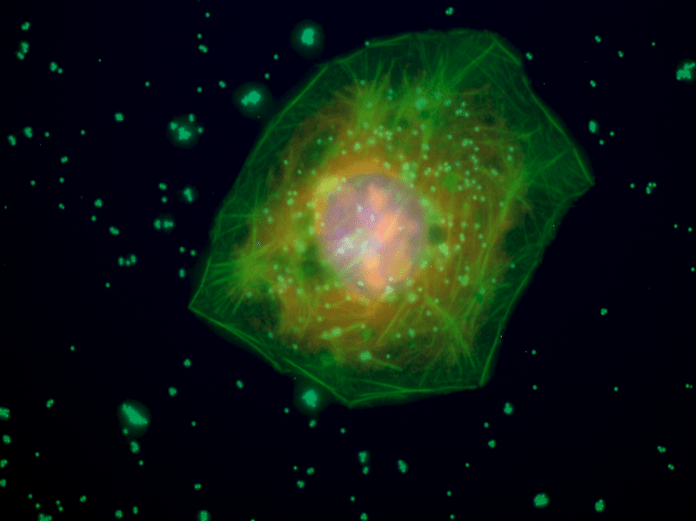ການສຶກສາທີ່ຜ່ານມາກ່ຽວກັບ ພາດສະຕິກ pollution beyond the micron level has unambiguously detected and identified nanoplastics in real-life samples of bottled ນ້ໍາ. It was found that the exposure to the micro-nano ພລາສຕິກ from regular bottled ນ້ໍາ is in the range of 105 particles per litre. The micro-nano ພລາສຕິກ concentrations were estimated to be about 2.4 ± 1.3 × 105 particles per litre of bottled ນ້ໍາ, about 90% of which were nanoplastics. Nanoplastics, whose dimension is in the range of 10 -9 ແມັດ, ມີຂະຫນາດນ້ອຍພຽງພໍທີ່ຈະຂ້າມໄດ້ຢ່າງງ່າຍດາຍເຖິງແມ່ນວ່າເລືອດສະຫມອງ barrier ແລະອຸປະສັກຂອງ placenta ແລະອາດຈະສົ່ງຜົນສະທ້ອນເຖິງສຸຂະພາບຂອງມະນຸດ.
In a study conducted in 2018, researchers investigated globally sourced brands of bottled ນ້ໍາ for microplastic contamination using Nile Red tagging. They found an average of 10.4 microplastic particles more than 100 µm (1 micron or micrometer = 1 µm = 10⁻⁶ meter) in size per litre of bottled ນ້ໍາ. Particles smaller than 100 µm could not be confirmed to be ພາດສະຕິກ due to limitation of spectroscopic analysis however dye adsorption indicated so. Such smaller particles (in the size range 6.5µm –100 µm) were, on an average, 325 in number per litre of bottled ນ້ໍາ.
ໃນປັດຈຸບັນນັກຄົ້ນຄວ້າໄດ້ເອົາຊະນະຂໍ້ຈໍາກັດດ້ານວິຊາການຂອງການວິເຄາະ spectroscopic ໃນການສຶກສາອະນຸພາກຂະຫນາດນ້ອຍກວ່າ 100 µm. ໃນການສຶກສາທີ່ຜ່ານມາ, ພວກເຂົາເຈົ້າລາຍງານການພັດທະນາເຕັກນິກການຖ່າຍຮູບ optical ທີ່ມີປະສິດທິພາບທີ່ມີລະບົບການກໍານົດອັດຕະໂນມັດທີ່ສາມາດກໍານົດແລະວິເຄາະອະນຸພາກພາດສະຕິກໃນລະດັບ nano (1 nanometer = 1 nm = 10).-9 meter). Study of bottled ນ້ໍາ using the newly developed technique revealed per litre of bottled ນ້ໍາ has about 2.4 ± 1.3 × 105 ອະນຸພາກພລາສຕິກ, ປະມານ 90% ແມ່ນ nanoplastics. ນີ້ແມ່ນຫຼາຍກ່ວາ microplastic ລາຍງານໃນການສຶກສາກ່ອນຫນ້ານີ້.
ການສຶກສານີ້ບໍ່ພຽງແຕ່ເພີ່ມພື້ນຖານຄວາມຮູ້ກ່ຽວກັບມົນລະພິດພາດສະຕິກເທົ່ານັ້ນ, ແຕ່ຍັງຊີ້ໃຫ້ເຫັນວ່າການແຕກແຍກຂອງພາດສະຕິກຍັງສືບຕໍ່ຢູ່ໃນລະດັບ nano ຈາກລະດັບຈຸນລະພາກ. ໃນລະດັບນີ້, ພລາສຕິກ ສາມາດຂ້າມສິ່ງກີດຂວາງທາງຊີວະພາບເຊັ່ນ: ອຸປະສັກເລືອດສະຫມອງແລະອຸປະສັກຂອງ placenta ແລະເຂົ້າສູ່ລະບົບຊີວະພາບເຊິ່ງເປັນສາເຫດຂອງຄວາມກັງວົນຕໍ່ສຸຂະພາບຂອງມະນຸດ.
ຫຼັກຖານກ່ຽວກັບຄວາມເປັນພິດທີ່ມີທ່າແຮງຂອງ nanoplastics ແລະເປັນອັນຕະລາຍຕໍ່ສຸຂະພາບຂອງມະນຸດແມ່ນຈໍາກັດ, ຢ່າງໃດກໍຕາມ, ມີການມີສ່ວນຮ່ວມໃນຄວາມກົດດັນທາງດ້ານຮ່າງກາຍແລະຄວາມເສຍຫາຍ, apoptosis, necrosis, ການອັກເສບ, ຄວາມກົດດັນ oxidative ແລະການຕອບສະຫນອງຂອງພູມຕ້ານທານ.
***
ເອກະສານ:
1. Mason S.A., Welch V.G. and Neratko J. 2018. Synthetic Polymer Contamination in Bottled ນ້ໍາ. Frontiers in Chemistry. Published 11 September 2018. Sec. Analytical Chemistry Volume 6. DOI: https://doi.org/10.3389/fchem.2018.00407
2. Qian N., et al 2024. ການຖ່າຍພາບທາງເຄມີຂອງອະນຸພາກດຽວຢ່າງໄວວາຂອງ nanoplastics ໂດຍກ້ອງຈຸລະທັດ SRS. ຈັດພີມມາໃນວັນທີ 8 ມັງກອນ 2024. PNAS. 121 (3) e2300582121. DOI: https://doi.org/10.1073/pnas.2300582121
3. Yee MS et al 2021. ຜົນກະທົບຂອງ Microplastics ແລະ Nanoplastics ຕໍ່ສຸຂະພາບຂອງມະນຸດ. ວັດສະດຸນາໂນ. ເຫຼັ້ມທີ 11. ສະບັບທີ 2. DOI: https://doi.org/10.3390/nano11020496
***






































